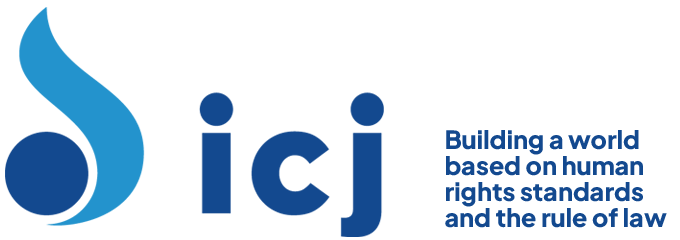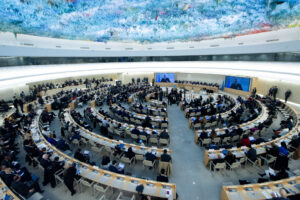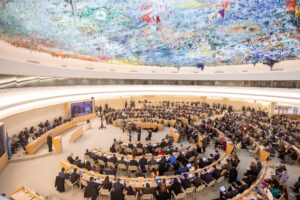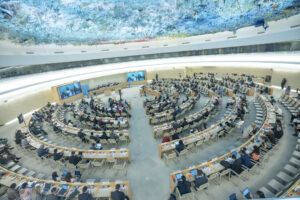2.1 The author is an openly lesbian woman and an activist in the field of lesbian, gay, bisexual and transgender (LGBT) rights in the Russian Federation. In 2009 she, together with other individuals, tried to hold a peaceful assembly in Moscow (so called “Gay Pride”), which was banned by the Moscow authorities. A similar initiative to hold a march and a “picket” to promote tolerance towards gays and lesbians was banned in the city of Ryazan in 2009.
2.2 On 30 March 2009, the author displayed posters that declared “Homosexuality is normal” and “I am proud of my homosexuality” near a secondary school building in Ryazan. According to her, the purpose of this action was to promote tolerance towards gay and lesbian individuals in the Russian Federation.
Author’s comments on the State party’s observations
5.8 The author submits a copy of the legal opinion prepared by the International Commission of Jurists upon her request and asks the Committee to take it into account in considering the merits of her communication.
5.9 In its legal opinion, the International Commission of Jurists firstly considers the effect of the Committee’s Views in Hertzberg et al. v. Finland, {{7}} in which it accepted, as a justification provided for in article 19, paragraph 3, of the Covenant, the public morals limitation invoked by the Government of Finland in defence of paragraph 9 of chapter 20 of the Finnish Penal Code, which provided that anyone who “publicly encourages indecent behaviour between persons of the same sex” was subject to a six-month prison sentence or a fine. The International Commission of Jurists submits that the outcome in the said communication is not dispositive of this matter, because:
- Equality law, in the jurisprudence of the Committee and other human rights bodies, has developed significantly since April 1982 when the Views in Hertzberg et al. v. Finland were adopted. At that time, sexual orientation was not recognized as a status protected from discrimination and now it is; {{8}}
- Also since 1982, the Committee and other institutions have recognized that limitations on rights must not violate the prohibition of discrimination. Even a limitation with a permissible aim – such as the protection of public morality – may not be discriminatory;
- Conceptions of public morality are subject to change {{9}} and what was considered justifiable with reference to public morality in 1982 is no longer the case today. Laws similar to paragraph 9 of chapter 20 of the Finnish Penal Code have since been repealed in States such as Austria and the United Kingdom of Great Britain and Northern Ireland. Furthermore, the Committee’s jurisprudence reflects the evolution of the “public morals” conceptions, as does the case law of the European Court of Human Rights.{{10}}
5.10 The International Commission of Jurists then submits that the Ryazan Region Law is an impermissible limitation of freedom of expression because it is discriminatory, for the following reasons:
- sexual orientation is a protected ground under articles 2 and 26 of the Covenant {{11}};
- limitations on rights cannot be discriminatory, whether in law or practice –a law that differentiates on the basis of sexual orientation is therefore discriminatory, in violation of the Covenant, unless it has a reasonable and objective justification, and is aimed at a legitimate purpose; and
- public morality is not a reasonable and objective justification.
5.11 The International Commission of Jurists argues that enjoyment of all Convention rights without discrimination means that the freedom of expression of LGBT individuals, as well as the expression concerning sexual orientation and same-sex relationships cannot be restricted in a discriminatory manner. Any restriction on expression about sexuality must be neutral with respect to sexual orientation{{12}}. Laws restricting freedom of expression must be compatible with the aims and objectives of the Covenant and must not violate its non-discrimination provisions{{13}}. They may not be imposed for discriminatory purposes or applied in a discriminatory manner {{14}}. The International Commission of Jurists argues that even the proportionate use of a permissible aim, such as public morality, cannot be the basis for a restriction on freedom of expression if it is applied in a discriminatory manner. Therefore, by penalizing “public actions aimed at propaganda of homosexuality” – as opposed to propaganda of heterosexuality or sexuality generally – the Ryazan Region Law enacts a difference in treatment that cannot be justified. It singles out one particular kind of sexual behaviour for differential treatment. It does so even though sexual relationships between consenting adults of the same sex are not illegal in the Russian Federation.
5.12 Furthermore, although not every differentiation of treatment will constitute discrimination, the criteria for such differentiation must be reasonable and objective and the aim must be to achieve a purpose that is legitimate under the Covenant {{15}}. Because sexual orientation is a prohibited ground, a difference in treatment founded on sexual orientation constitutes discrimination, in violation of the Covenant, unless there is a “reasonable and objective” justification {{16}}. Public morality does not amount to such a justification. Since Hertzberg et al. v. Finland, public morality arguments have diminished in weight {{17}}. The International Commission of Jurists submits that courts around the world have held that public morality is not a sufficient reason to justify a difference in treatment and established that concerns about public morality cannot serve to defend disparate treatment based on sexual orientation {{18}}. It adds that the Ryazan Region Law is clearly intended to target any information about homosexuality, including information that is in no manner “obscene” under criminal law.
5.13 The International Commission of Jurists further submits that the Ryazan Region Law also has serious implications for the right of children to receive information. In addition to article 19, paragraph 2, of the Covenant, the right of children to receive information concerning sexuality is specifically protected under article 13 of the Convention on the Rights of the Child {{19}}. The right of children to receive information about sexuality and sexual orientation is related to their rights to education and to health {{20}}.
5.14 For the foregoing reasons, the International Commission of Jurists concludes that section 3.10 of the Ryazan Region Law contravenes the State party’s obligations under the Covenant.
Consideration of the Merits
10.2 The first issue before the Committee is whether or not the application of section 3.10 of the Ryazan Region Law to the author’s case, resulting in her conviction of an administrative offence and the subsequent fine, constituted a restriction within the meaning of article 19, paragraph 3, on the author’s right to freedom of expression. The Committee notes that section 3.10 of the Ryazan Region Law establishes administrative liability for “propaganda of homosexuality (sexual act between men or lesbianism) among minors”. The Committee observes, however, that the wording of section 3.10 of the Ryazan Region Law is ambiguous as to whether the term “homosexuality (sexual act between men or lesbianism)” refers to one’s sexual identity or sexual activity or both. In any case, there is no doubt that there has been a restriction on the exercise of the author’s right to freedom of expression guaranteed by article 19, paragraph 2, of the Covenant {{21}}. In fact, the existence of the restriction in the present communication is not in dispute between the parties.
10.3 The Committee then has to consider whether the restriction imposed on the author’s right to freedom of expression is justified under article 19, paragraph 3, of the Covenant, i.e. provided by law and necessary: (a) for respect of the rights or reputations of others; and (b) for the protection of national security or of public order (ordre public), or of public health or morals. The Committee recalls in this respect its general comment No. 34 (2011) on article 19 (freedoms of opinion and expression) of the International Covenant on Civil and Political Rights {{22}}, in which it stated, inter alia, that freedom of opinion and freedom of expression are indispensable conditions for the full development of the person, that they are essential for any society, and that they constitute the foundation stone for every free and democratic society {{23}}. Any restrictions to their exercise must conform to the strict tests of necessity and proportionality and “must be applied only for those purposes for which they were prescribed and must be directly related to the specific need on which they are predicated” {{24}}.
10.4 The Committee observes that, in the present case, the author and the State party disagree as to whether the restriction on the exercise of the right to freedom of expression is “provided by law”. In particular, the author argues with reference to article 55, paragraph 3, of the Constitution, that freedom of expression can be restricted only by federal law, whereas the Ryazan Region Law on the basis of which she was convicted of an administrative offence for “propaganda of homosexuality among minors” is not a federal law. The State party in turn submits that the Ryazan Region Law is based on the Constitution and the Code on Administrative Offences, thus it is a part of the law on administrative offences. The Committee may dispense with considering this point because, irrespective of the domestic lawfulness of the restriction in question, laws restricting the rights enumerated in article 19, paragraph 2, must not only comply with the strict requirements of article 19, paragraph 3, of the Covenant but must also themselves be compatible with the provisions, aims and objectives of the Covenant {{25}}, including the non-discrimination provisions of the Covenant {{26}}.
10.5 In this respect, the Committee recalls, as stated in its General Comment No. 34, that “‘the concept of morals derives from many social, philosophical and religious traditions; consequently, limitations … for the purpose of protecting morals must be based on principles not deriving exclusively from a single tradition’. Any such limitations must be understood in the light of universality of human rights and the principle of non-discrimination” {{27}}. In the present case, the Committee observes that section 3.10 of the Ryazan Region Law establishes administrative liability for “public actions aimed at propaganda of homosexuality (sexual act between men or lesbianism)” – as opposed to propaganda of heterosexuality or sexuality generally – among minors. With reference to its earlier jurisprudence {{28}}, the Committee recalls that the prohibition against discrimination under article 26 comprises also discrimination based on sexual orientation.
10.6 The Committee also recalls its constant jurisprudence that not every differentiation based on the grounds listed in article 26 of the Covenant amounts to discrimination, as long as it is based on reasonable and objective criteria {{29}}, in pursuit of an aim that is legitimate under the Covenant {{30}}. While noting that the State party invokes the aim to protect the morals, health, rights and legitimate interests of minors, the Committee considers that the State party has not shown that a restriction on the right to freedom of expression in relation to “propaganda of homosexuality” – as opposed to propaganda of heterosexuality or sexuality generally – among minors is based on reasonable and objective criteria. Moreover, no evidence which would point to the existence of factors justifying such a distinction has been advanced {{31}}.
10.7 Furthermore, the Committee is of the view that, by displaying posters that declared “Homosexuality is normal” and “I am proud of my homosexuality” near a secondary school building, the author has not made any public actions aimed at involving minors in any particular sexual activity or at advocating any particular sexual orientation. Instead, she was giving expression to her sexual identity and seeking understanding for it.
10.8 The Committee notes the State party’s arguments that the author had a deliberate intent to engage children in the discussion of the issues raised by her actions; that the public became aware of the author’s views exclusively on the initiative of the latter; that her actions from the very beginning had an “element of provocation” and her private life was not of interest either to the public or to minors, and that the public authorities did not interfere with her private life (see paragraph 6.2 above). While the Committee recognizes the role of the State party’s authorities in protecting the welfare of minors, it observes that the State party failed to demonstrate why, on the facts of the present communication, it was necessary for one of the legitimate purposes of article 19, paragraph 3, of the Covenant to restrict the author’s right to freedom of expression on the basis of section 3.10 of the Ryazan Region Law, for expressing her sexual identity and seeking understanding for it, even if indeed, as argued by the State party, she intended to engage children in the discussion of issues related to homosexuality. Accordingly, the Committee concludes that the author’s conviction of an administrative offence for “propaganda of homosexuality among minors” on the basis of the ambiguous and discriminatory section 3.10 of the Ryazan Region Law, amounted to a violation of her rights under article 19, paragraph 2, read in conjunction with article 26 of the Covenant.
[[7]]7. Communication No. 61/1979, Hertzberg et al. v. Finland, Views adopted on 2 April 1982 [[7]].
[[8]]8. Reference is made to communication No. 488/1992, Toonen v. Australia, Views adopted on 31 March 1994, paragraph 8.7 [[8]].
[[9]]9. Reference is made to the Individual Opinion of Torkel Opsahl in Hertzberg et al. v. Finland [[9]].
[[10]]10. Reference is made to Toonen v. Australia; and judgment of the European Court of Human Rights in Dudgeon v. United Kingdom (application No. 7525/76), 22 October 1981 [[10]].
[[11]]11. Reference is made to Toonen v. Australia; communication No. 941/2000, Young v. Australia, Views adopted on 6 August 2003, paragraph 10.4. See also, general comment No. 20 (2009) of the Committee on Economic, Social and Cultural Rights on non-discrimination in economic, social and cultural rights, Official Records of the Economic and Social Council, 2010, Supplement No. 2 (E/2010/22), annex VI, para. 32; general comment No. 2 (2007) of the Committee against Torture on implementation of article 2 by States parties, Official Records of the General Assembly, Sixty-third Session, Supplement No. 44 (A/63/44), annex VI, para. 21; general comment No. 4 (2003) of the Committee on the Rights of the Child on adolescent health and development in the context of the Convention on the Rights of the Child, Official Records of the General Assembly, Fifty-ninth Session, Supplement No. 41 (A/59/41), annex X, para. 6 [[11]].
[[12]]12. Reference is made to the recommendation CM/Rec(2010)5 of the Committee of Ministers of the Council of Europe to member states on measures to combat discrimination on grounds of sexual orientation or gender identity, adopted on 31 March 2010. Available from https://wcd.coe.int/ViewDoc.jsp?id=1606669 [[12]].
[[13]]13. Siracusa Principles on the Limitation and Derogation of Provisions in the International Covenant on Civil and Political Rights, annex, E/CN.4/1985/4, principle 2; Committee’s general comment No. 22 (1993) on the right to freedom of thought, conscience and religion, Official Records of the General Assembly, Forty-eighth Session, Supplement No. 40 (A/48/40), annex VI, para. 8 [[13]].
[[14]]14. Committee’s general comment No. 22, para. 8; and the Individual Opinion of Torkel Opsahl in Hertzberg et al. v. Finland [[14]].
[[15]]15. Reference is made to the Committee’s general comment No. 18 (1989) on non-discrimination, Official Records of the General Assembly, Forty-fifth Session, Supplement No. 40, vol. I (A/45/40 (Vol. I)), annex VI, sect. A, paragraph 13 [[15]].
[[16]]16. General comment No. 20 (2009) of the Committee on Economic, Social and Cultural Rights, para. 13 [[16]].
[[17]]17. Reference is made to Toonen v. Australia, paragraph 8.6; and judgment of the European Court of Human Rights in Open Door and Dublin Well Woman v. Ireland (applications Nos. 14234/88 and 14235/88), 29 October 1992, paragraphs 65–66 [[17]].
[[18]]18. The legal opinion, inter alia, quotes the case law of the United States Supreme Court, the Constitutional Court of South Africa and the Philippines Supreme Court [[18]].
[[19]]19. Reference is also made to the general comment No. 3 (2003) of the Committee on the Rights of the Child on HIV/AIDS and the Rights of the Child, Official Records of the General Assembly, Fifty-ninth Session, Supplement No. 41 (A59/41), annex IX, para. 16; and the concluding observations of the Committee on the Rights of the Child on the second periodic report of the United Kingdom of Great Britain and Northern Ireland, CRC/C/15/Add.188, para. 44 (d) [[19]].
[[20]]20. Reference is made to the reports of the Special Rapporteur on the right to education, A/HRC/8/10/Add.1, paragraphs 79–84, and A/HRC/4/29/Add.1, paragraphs 34–37. See also, decision of the European Committee of Social Rights, INTERIGHTS v. Croatia (complaint No. 45/2007), 30 March 2009 [[20]].
[[21]]21. Communication No.780/1997, Laptsevich v. Belarus, Views adopted on 20 March 2000, para. 8.1 [[21]].
[[22]]22. Official Records of the General Assembly, Sixty-sixth session, Supplement No. 40 (A/66/40 (Vol. I)), annex V [[22]].
[[23]]23. See ibid., para. 2 [[23]].
[[24]]24. Ibid., para. 22 [[24]].
[[25]]25. See ibid., para. 26; and Toonen v. Australia, para. 8.3 [[25]].
[[26]]26. General comment No. 34, para. 26, and General comment No. 18, para. 13 [[26]].
[[27]]27. General comment No. 34, para. 32 [[27]].
[[28]]28. See Toonen v. Australia, para. 8.7; Young v. Australia, para. 10.4; and communication No. 1361/2005, X. v. Colombia, Views adopted on 30 March 2007, para. 7.2 [[28]].
[[29]]29. See, inter alia, communication No. 172/1984, Broeks v. the Netherlands, Views adopted on 9 April 1982, para. 13; communication No. 182/1984, Zwaan-de Vries v. the Netherlands, Views adopted on 9 April 1987, para.13; communication No. 218/1986, Vos v. the Netherlands, Views adopted on 29 March 1989, para 11.3; communication No. 415/1990, Pauger v. Austria, Views adopted on 26 March 1992, para 7.3; communication No. 919/2000, Müller and Engelhard v. Namibia, Views adopted on 26 March 2002, para 6.7; and communication No. 976/2001, Derksen v. the Netherlands, Views adopted on 1 April 2004, para. 9.2 [[29]].
[[30]]30. See, inter alia, communication No. 1314/2004, O’Neill and Quinn v. Ireland, Views adopted on 24 July 2006, para. 8.3 [[30]].
[[31]]31. See Young v. Australia, para. 10.4; and X. v. Colombia, para. 7.2 [[31]].
Link to full text of the report: Communication-CCPR-Russian Federation-2012-eng




